The contemporary landscape of drone technology has proliferated across various sectors, offering unprecedented capabilities in fields ranging from aerial photography to logistics. Yet, this rapid expansion necessitates a deep understanding of local drone laws to operate with legitimacy and integrity. Comprehending these drone regulations is not merely about adhering to the law; it is about mastering the requisites that ensure the safety and privacy of the broader community.
Therefore, whether you are an enthusiast capturing stunning vistas or a commercial entity leveraging the utility of Unmanned Aerial Vehicles (UAVs), knowing the UAV guidelines is critical. The legal requirements for drones shape the framework within which enthusiasts and professionals alike must operate to avoid penalties, preserve their investments, and maintain the trust of those they serve. Stay tuned as we explore the essentials of drone compliance, providing a clear flight path for safe and responsible drone operation.
Emphasizing the Importance of Drone Law Compliance
As the skies become increasingly populated with drones, understanding local drone laws is critical for the harmonious integration of this technology into our daily lives. These regulations serve as the cornerstone for safety, privacy, and legal adherence, guiding enthusiasts and professionals in the realm of Unmanned Aerial Vehicles (UAVs). Let’s delve into why compliance with these laws isn’t just a legal formality, but a fundamental aspect of responsible drone operation.
Safety Concerns and Risk Management
The proliferation of drones across various sectors holds immense promise but also brings forth safety concerns that cannot be ignored. Strict drone flying restrictions aim to mitigate the risk of aerial accidents, ensuring that UAVs do not pose a threat to manned aircraft, vulnerable infrastructures, or public safety. From altitude limits to restrictions near airports, drone legislation is pivotal in managing the potential risks associated with UAV operations.
Privacy Protection and Ethical Flying
As drones are capable of reaching areas otherwise inaccessible, they also bring new challenges to individual privacy. Draconian as some laws might seem, they are paramount in protecting the sanctity of personal and commercial spaces. Flying drones legally becomes synonymous with respecting boundaries and showcases the operator’s commitment to ethical flying practices.
Legal Repercussions and Fines
Disregarding local drone laws can result in stringent legal consequences including hefty fines and, in some severe cases, criminal charges. Such punitive measures emphasize the seriousness with which authorities treat unlawful drone operations and the importance they place on adhering to legislated requirements.
Investment and Professional Reputation
For commercial drone operators, compliance isn’t just about avoiding penalties; it’s about safeguarding their investment and reputation in a growing industry. Slacking on regulations can lead to financial loss due to equipment confiscation or business suspension, making legal vigilance a non-negotiable aspect of professional drone operation.
Worldwide Perspective on Drone Legislation
Drone technology has taken to the skies at a prodigious rate, and with this ascent, the international horizon of UAV regulation presents a diverse mosaic that pilots must carefully navigate. The intersection of advancement in drone applications and the preservation of public safety and privacy has forged varied legislative frameworks around the globe. These frameworks are distinct reflections of the regional priorities and are informed by the expertise of respective civil aviation authorities, including the Federal Aviation Administration (FAA), the European Union Aviation Safety Agency (EASA), Transport Canada, and the Civil Aviation Safety Authority (CASA).
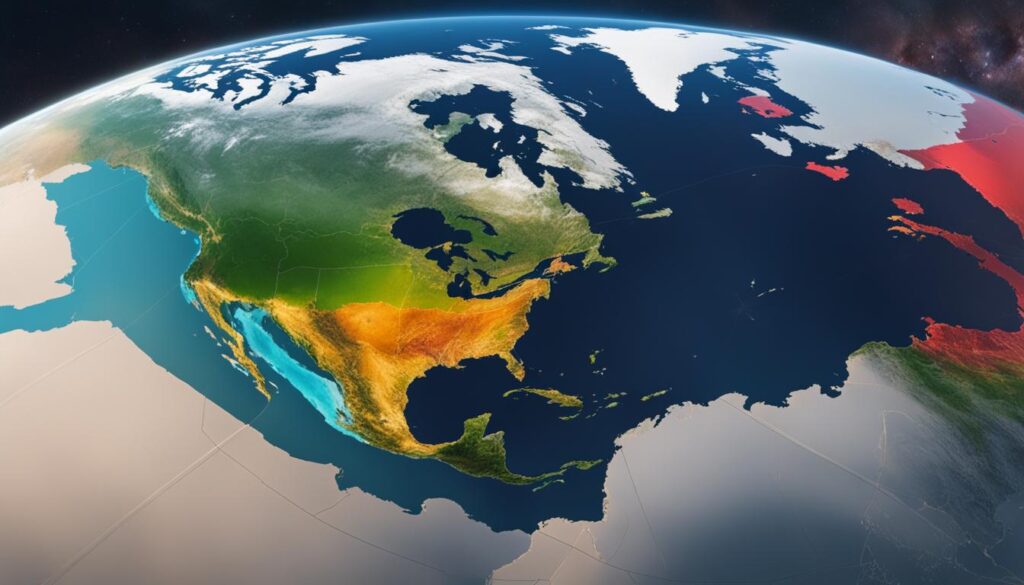
Drones in the United States: FAA Oversight
In the United States, the FAA drone regulations are recognized for establishing comprehensive guidelines that dictate drone operation within national airspace. The FAA requires all drones weighing more than 0.55 pounds to be registered, and commercial drone pilots to attain a Part 107 certification – a testament to the stringent standards imposed to ensure secure and responsible flying practices.
European Union: EASA’s Framework
The European Union, through the EASA, has delineated regulations that classify drones and enforce registration requirements. Those UAVs exceeding 250 grams or equipped with sensory recording equipment like cameras fall under their regulatory purview, ensuring that drone operations harmonize with the overarching public safety and privacy mandates across member countries.
Drone Environment in Canada: Transport Canada’s Regulations
Northward, in Canada, Transport Canada has mirrored the proactive approach of its international counterparts in creating a safe and regulated environment for drone operation. The body enforces strict adherence to a 120-meter flying altitude limit and has delineated regulations that mandate pilot certification, thereby aligning with the global commitment to airspace safety.
Australia’s Approach to UAV Guidelines
Shifting focus to Australia, CASA has drawn up UAV guidelines that resonate with the proactive stance on securing skies while fostering drone technology’s innovative strides. Australian regulations require that pilots operate their UAVs within specified altitude limits and demand certifications similar to those of Canadian protocols.
Regulatory Landscape Across Asia
The variegated expanse of Asia presents a more varied patchwork of drone regulations, with individual countries enacting legislation tailored to their unique geographical and socio-political circumstances. Common requirements include drone registration, pilot licensing, and prohibition of UAV operation in the vicinity of sensitive locations such as airports and government installations. Asia’s regulatory approach underscores the importance of conforming to local aviation laws by international UAV operators.
Whether taking to the skies for leisure or commercial pursuits, understanding and adhering to the local aviation laws of the jurisdiction in question remains paramount. The global panorama of drone regulations – from the FAA’s frameworks in the U.S. to EASA, Transport Canada, and CASA’s guidelines – illustrates the imperative for pilot diligence in the pursuit of compliant and responsible drone usage.
Understanding Local Drone Laws
Local aviation laws and drone ordinance are key components in the legal framework defining how individuals and organizations can operate drones within a region. With a rapidly evolving landscape, Understanding Local Drone Laws becomes integral to ensuring that drone enthusiasts and professionals abide by legal requirements for drones. These regulations are enacted not just to maintain safety and privacy but also to harmonize the burgeoning drone activities with existing national and international airspace systems.
One universal aspect of drone laws across various jurisdictions is the drone registration process. Registration typically involves submitting details about the drone and its intended use, which helps authorities monitor and manage drone traffic. Additionally, most regulations include a component that sets the operational altitude to ensure there’s minimal interference with manned aircraft. These stipulations can vary, but they often hover around a benchmark elevation limit for the operational zone.
Another pivotal area of regulation is the visual line of sight requirement, where operators are required to keep their drones within eye contact at all times to prevent accidents or intrusions on privacy. This is particularly important in densely populated areas or near sensitive installations. Furthermore, each region has particular no-fly zones, including but not limited to areas around airports, military installations, and national parks. Understanding and adhering to these drone laws ensures that operators can responsibly enjoy their activity without transgressing legal boundaries.
| Country/Region | Drone Registration Required | Max Operational Altitude | Visual Line of Sight Required | Common No-Fly Zones |
|---|---|---|---|---|
| United States | Yes – Drones over 0.55 lbs | 400 feet AGL | Yes | Airports, National Parks |
| European Union | Yes – Drones over 250 grams or with camera | 120 meters AGL | Yes | Sensitive Areas, Ecological Reserves |
| Canada | Yes – Drones over 250 grams | 90 meters AGL | Yes | Airports, Military Bases |
| Australia | Yes – For commercial purposes | 120 meters AGL | Yes | Populated Beaches, Private Properties |
| Asia | Varies by country | Varies by country | Usually | Government Buildings, Airports |
As the interest in unmanned aerial vehicles (UAVs) continues to climb, knowledge-sharing platforms and databases have become more prevalent, assisting in demystifying local aviation laws. Potential and existing drone operators are encouraged to leverage these resources to ensure compliance and to stay up-to-date with any changes in legislation, thereby promoting safety, privacy, and the free but responsible use of drone technology.
Licensing and Certification for Drone Operation
As the drone industry’s landscape continuously evolves, a clear understanding of the licensing and certification requirements is essential for both recreational flyers and commercial operators. The distinctions between the types of licensing and the specific legal stipulations involved in operating UAVs are aspects that those in the field must familiarize themselves with to operate within the bounds of local drone regulations.
Commercial vs. Recreational Drone Licenses
The classification of drone pilots as commercial or recreational plays a pivotal role in the type of licensing required, with significant differences dictated by regulatory bodies across the world. In the United States, the Federal Aviation Administration (FAA) enforces that all commercial drone pilots obtain a Part 107 Remote Pilot Certificate, while recreational fliers are subject to less stringent rules but still must follow specific UAV guidelines.
Operating a Drone: Legal Requirements
Ensuring compliance with legal requirements is a necessary step for operating a drone responsibly and lawfully. Acquiring proper documentation such as the Part 107 Remote Pilot Certificate in the U.S. or the Remote Pilot Licence (RePL) in Australia for commercial operations is not only a regulatory mandate but also a measure of preparedness and proficiency as a drone pilot.
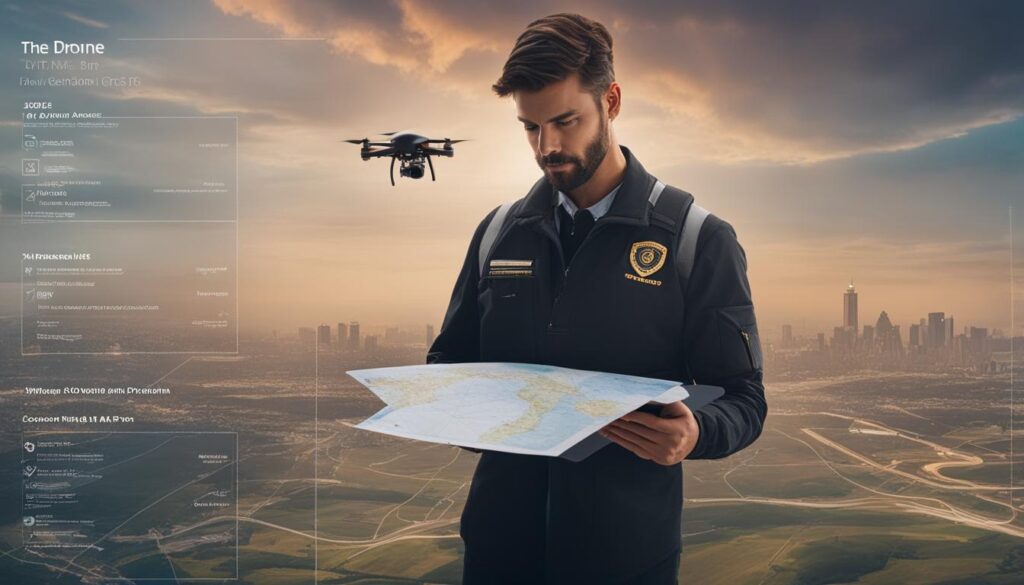
Navigating the Certification Process
Navigating the path to certification can be challenging; drone pilots must adhere to a sequence of steps, including studying for exams, obtaining required flight hours, and understanding the nuances of local UAV guidelines. Take note of the table below which outlines crucial aspects of the certification process across various regions.
| Region | Type of License | Requirement for Recreational Use | Requirement for Commercial Use |
|---|---|---|---|
| United States | Part 107 Remote Pilot Certificate | No certification | FAA written examination |
| Australia | Remote Pilot Licence (RePL) | Accreditation | RePL training and certification |
| Europe (EASA) | Operation Category-based License | Varies by drone class | Varies by operation category |
| Canada | Basic or Advanced Operations Certificate | Basic exam | Advanced exam and flight review |
Nuances and Variations in Local Aviation Laws
When exploring the complexities of Understanding Local Drone Laws, it becomes evident that there is an intricate tapestry of drone flying restrictions and drone legislation that varies significantly from one region to another. These legalities are not merely bureaucratic hurdles; they are critical safeguards designed to integrate drone operations seamlessly into existing aviation systems while ensuring public safety and security.
For instance, while some basic provisions such as height restrictions and no-fly zones near critical infrastructure are commonly shared across jurisdictions, the minutiae of these regulations can differ substantially. This not only affects hobbyists but also professional drone operators who must navigate through a labyrinth of legal requirements for drones that may impact everything from the type of drones they can operate to the permissions required for specific jobs.
| Aspect | Typical Restriction | Variances to Note |
|---|---|---|
| Max Altitude | 120 meters (400 feet) | Elevations can lower near airports or in controlled airspace |
| Proximity to Airports | 5-mile radius without permission | Extensions in place for sensitive installations |
| Operational Distance | Visual Line Of Sight (VLOS) | Beyond VLOS (BVLOS) permitted with special authorization |
| Weight Limits | Registration above 250g | Lesser limits for certain regions; additional certifications for heavier drones |
| Commercial Licensing | Often required for commercial use | Varies from basic to advanced certifications depending on the jurisdiction |
Adherence to local drone regulations is a responsibility that all operators must earnestly undertake. The need for education on these legal standards is pivotal, not only to uphold the law but to advance one’s enterprise or hobby without the setback of legal infringement. With the advancement of technology and the potential for new applications of drones, Understanding Local Drone Laws is an ongoing process—one that necessitates consistent vigilance and adaptability by UAV pilots.
Remember, the sky is not the limit when it comes to drone potential, but drone legislation just might be. It behooves every drone enthusiast or professional to not only fly within the bounds of aviation laws but to also contribute to the conversation and development of these regulations for the future of safe and effective drone flight.
Drone Ordinances and No-Fly Zones
Flying drones invokes excitement and opportunity, but it also requires strict adherence to drone regulations and UAV guidelines to ensure safety and legality. Among the critical areas that every drone operator must understand are no-fly zones (NFZs), which present unique challenges and NFZ restrictions that are pivotal to compliant flight operations. Knowledge of these zones, along with obtaining necessary certifications such as the Part 107, is central to a drone pilot’s education.
What Constitutes a No-Fly Zone?
No-fly zones are designated areas where drone flight is restricted or prohibited. NFZs typically surround locations such as airports, military bases, or other sensitive infrastructure to ensure national security, privacy, and safety. Mapping out these areas prior to flight is essential for any responsible drone pilot.
Identifying and Complying with NFZ Restrictions
Compliance with NFZ restrictions requires drone operators to be proactive in identifying areas restricted for UAV use. This involves utilizing both drone software with integrated maps and resources provided by national aviation authorities to pinpoint and observe the boundaries of these zones.
Permission Application Process for NFZ Access
In some circumstances, drones can enter no-fly zones with specific permission granted by the controlling authorities. The process involves submitting an application that showcases the drone operator’s capacity for responsible and safe flying, often demonstrated through certifications such as the Part 107.
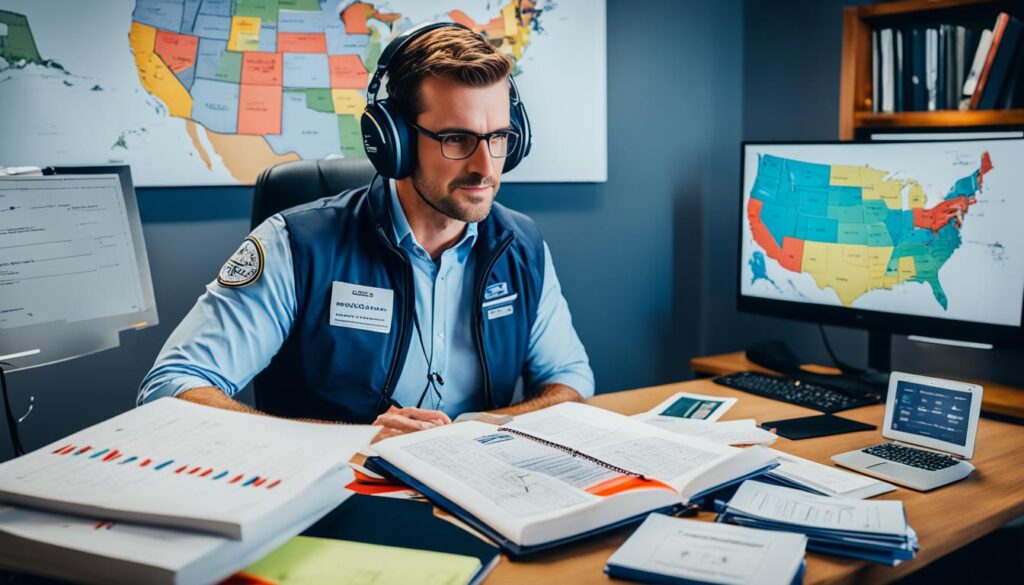
The following table highlights the specific information and steps involved in obtaining permission to fly within NFZs, which is particularly relevant for Part 107 certified pilots seeking to navigate these restricted spaces:
| Aspect of NFZ Access | Description | Requirement for Part 107 Pilots |
|---|---|---|
| Identification | Locating the NFZ and understanding its dimensions and specific restrictions. | Use of UAV software or aviation authority data. |
| Application Process | Official request for authorization to operate within an NFZ. | Possession of Part 107 certification and submission of safety plan. |
| Operational Guidelines | Following the prescribed rules for safe operation specific to the NFZ. | Adherence to operational guidelines as outlined by the aviation authority. |
| Permission Timeframe | Understanding the duration for which permission is granted, which may be time-bound. | Clear knowledge of the permission timeframe and planning flights accordingly. |
| Post-Approval Reporting | Requirement to report flight data post-authorization, if necessary. | Capability to provide detailed flight data and logs as per request. |
By mastering the processes and considerations associated with NFZs, drone operators, especially those with Part 107 certification, can navigate these restrictions while expanding their operational potential. Understanding these regulations is not optional but a cornerstone of professional and responsible UAV operation.
The Role of Drone Ordinance in Urban Planning
Urban centers represent an intricate tapestry of varying environments, each with its own unique characteristics and challenges. The proliferation of drones, or Unmanned Aerial Vehicles (UAVs), has introduced new dynamics into this complex mix—prompting city planners and municipal authorities to integrate comprehensive drone ordinances into their urban planning initiatives. Not only do these policies govern the ways in which drones can be employed within the confines of a city, but they also strive to mitigate potential disturbances to both privacy and public safety, all while embracing technological advancements.
Municipal drone regulations are not a one-size-fits-all matter. Instead, they require a bespoke approach tailored to the needs and concerns of individual urban areas. Acknowledging this, cities around the world are crafting guidelines and rules that address the essential points of drone integration—considering the impact on local infrastructure, airspace, privacy, and safety. These efforts seek a harmonious balance, ensuring that the advent of drone technology enhances urban life without compromising the fundamentals of city living.
- Privacy Protections: Given the potential for UAVs to capture imagery and data, local ordinances enforce strict measures to protect citizens’ privacy rights.
- Safety Measures: Drones are required to maintain a safe distance from populated areas and landmarks, with additional protocols during special events or emergencies.
- Infrastructural Concerns: Urban infrastructures, such as power lines and telecommunications systems, must be safeguarded from any interference potentially caused by drones.
Reflecting on these considerations, municipal authorities align their policies with broader UAV guidelines, creating a cohesive framework that facilitates sustainable urban growth alongside responsible drone usage. Collaborative efforts between lawmakers, technologists, and urban developers continue to drive the development of drone ordinances, ensuring their relevance amid the swift evolution of UAV applications.
The Future of Drone Delivery Services
As we stand on the cusp of a new era in logistics, drone delivery services are rapidly becoming a pivotal aspect of e-commerce and supply chain management. As this industry grows, organizations are faced with the challenge of navigating complex regulatory frameworks to pave the way for safe and efficient UAV operations. Ensuring compliance, safeguarding data, and fostering positive community relations are key to the success and acceptance of these services.
Compliance and Airspace Classification
Navigating the intricacies of drone regulations and airspace classification is a primary concern for companies offering drone delivery services. Operators must distinguish between controlled and uncontrolled airspace, and acquire the correct certifications to legally conduct operations. Staying current with UAV guidelines is crucial to ensure services are delivered safely and within the bounds of the law.
Safety Standards and Protocols for Drone Deliveries
In the quest to secure a reliable drone delivery network, the implementation of robust safety standards is paramount. These protocols include advanced collision avoidance technologies and rigorous pre-flight checks, ensuring that every delivery is conducted with the utmost concern for public safety and compliance with existing regulations.
Data Security and Cybersecurity Measures
The digital nature of drone operations necessitates stringent cybersecurity measures to protect sensitive data. Companies must employ state-of-the-art encryption and secure data practices to prevent unauthorized access and ensure customer trust in the face of increasing cyber threats.
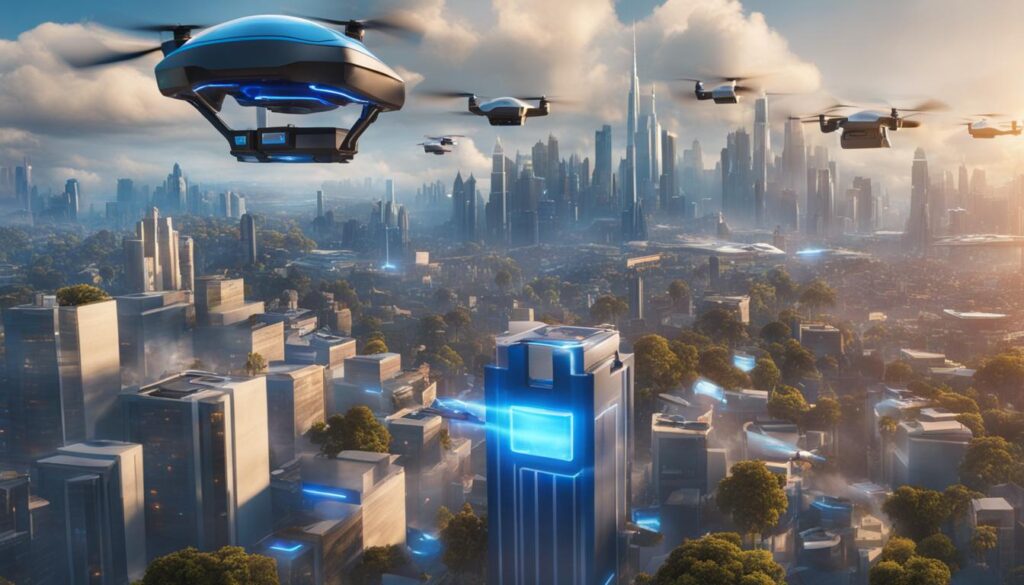
Community Engagement and Outreach
Building a strong rapport with the community is essential for the long-term viability of drone delivery systems. Engaging with residents and stakeholders gives companies the opportunity to address potential privacy and noise issues, thereby garnering support and fostering positive relationships with those who will be impacted by these services.
Insurance and Liability in Drone Services
Ensuring that drone delivery operations are backed by comprehensive insurance coverage is critical in mitigating risks and liabilities. As the skyline buzzes with an increasing number of UAVs, safeguarding against potential damages or accidents becomes an indispensable component of the operational framework.
In summation, as drone delivery services carve a niche in modern commerce, continuous adaptation and keen awareness of the evolving landscape of drone technology and legislation will be the hallmarks of pioneering companies committed to excellence in UAV logistics.
Strategies for Navigating and Flying Drones Legally
The legal landscape for drone operations can be intricate, with regulations that vary across jurisdictions. For those endeavoring to ensure their drone flights remain within the bounds of the law, a combination of preparedness, technology, and community interaction can form a robust framework for flying drones legally. Each can help a pilot to understand drone legislation and uphold a high standard of drone compliance.
Comprehensive Planning and Regulatory Research
Embarking on any drone flight begins with a solid foundation of research and planning. It is crucial for drone operators to familiarize themselves with the laws that govern UAV flight in their specific region. This involves staying updated on the latest drone legislation, securing any necessary permits, and understanding airspace restrictions. A proactive approach to researching regulations can prevent inadvertent breaches of law and protect pilots from penalties.
Enlisting Technology for Compliance Tracking
Technology emerges as a vital ally in the mission to fly drones responsibly. Utilizing apps and software created for drone compliance can streamline the process of adhering to regulations, especially with real-time updates on temporary flight restrictions (TFRs) and no-fly zones. Such tools can serve as navigational aides, ensuring drones do not inadvertently enter unauthorized airspaces and pilots stay informed of their legal obligations.
Engaging with Local Drone Communities for Best Practices
Collaborative wisdom sourced from local drone communities offers invaluable insights into best practices. Participation in forums and groups fosters an environment where information on drone compliance is shared, including experiences, tips, and advice from fellow enthusiasts. By engaging with these communities, pilots can benefit from collective knowledge and keep abreast of the expanding horizons of drone legislation.
Conclusion
As the horizon of drone technology continues to expand, the imperative for Understanding Local Drone Laws is more relevant than ever before. The essence of UAV usage, whether for capturing breathtaking aerial footage or for the prompt delivery of goods, is anchored to a framework of safety, privacy, and compliance. The myriad of applications for drones is matched only by the complexity and breadth of drone regulations and flying restrictions that govern the skies.
For drone enthusiasts and professionals alike, an in-depth knowledge of UAV guidelines is non-negotiable. It is this foundation of knowledge that paves the way for innovation and ensures that drone operations enhance, rather than endanger, the tapestry of our shared airspace. The commitment to staying updated with changes in drone flying restrictions, combined with a proactive approach to community engagement, sets a responsible precedent for the burgeoning drone industry.
As we continue to witness the rise of drones in countless commercial and recreational settings, the onus is upon each operator to become a steadfast adherent to local aviation laws. Through collective responsibility and informed operation, the drone community can soar to new heights of achievement while navigating the regulatory landscape with confidence and integrity.
FAQ
Why is understanding local drone laws important?
Understanding local drone laws is crucial for ensuring the safety of airspace, respecting privacy, avoiding legal repercussions, and maintaining a drone operator’s professional reputation and investment. It’s about flying responsibly and ethically within the legal boundaries set by local aviation laws and regulations.
What are the common legal requirements for flying drones?
Common legal requirements often include drone registration, adherence to altitude and flight restrictions, obtaining necessary pilot certifications or licenses, and operating the drone within the visual line of sight. Regulations may also dictate no-fly zones and airspace classifications for UAV operation.
How do the FAA’s regulations impact drone operators in the United States?
The Federal Aviation Administration (FAA) requires drone operators in the United States to register their UAVs if they weigh more than 0.55 lbs. Commercial operators are additionally required to obtain a Part 107 Remote Pilot Certificate and adhere to specific operational guidelines such as maintaining a maximum altitude of 400 feet.
How does EASA categorize drones?
The European Union Aviation Safety Agency (EASA) categorizes drones based on risk factors, which include the drone’s weight and whether it is equipped with a camera. Drones over 250 grams or those with cameras generally require registration, and operators must follow the specific regulations placed on each category of drone.
What distinguishes commercial from recreational drone licenses?
Commercial drone licenses typically require operators to undergo a more rigorous certification process, involving formal testing and adherence to stricter operational rules. Recreational drone users often have fewer requirements but still must operate their drones within the bounds of applicable local laws and guidelines.
What constitutes a no-fly zone (NFZ)?
No-fly zones are regions where the operation of drones is heavily restricted or entirely forbidden, often due to national security, safety, or privacy concerns. These areas commonly include airports, military bases, government buildings, and national parks.
Are there specific drone ordinances for urban areas?
Yes, many urban areas have specific drone ordinances that address the unique safety, privacy, and infrastructure concerns of densely populated environments. These laws may regulate flight paths, drone operation hours, surveillance capabilities, and may even impact delivery services.
What protocols should be followed for drone delivery services?
Drone delivery services must follow strict protocols, including navigating airspace classifications, obtaining necessary permissions, adhering to safety and cybersecurity measures, engaging with the community to discuss privacy and noise concerns, and securing comprehensive liability insurance.
How can drone operators navigate complex legal requirements?
Drone operators can navigate complex legal requirements by conducting comprehensive planning, employing technology to help with compliance tracking, and staying up to date with changing regulations. Additionally, engaging with local drone communities can provide insights into best practices and regulatory updates.
What strategies can help ensure legal compliance for drone pilots?
Strategies for ensuring legal compliance include thorough regulatory research, using drone-specific apps for compliance tracking, and checking updated maps for no-fly zones and airspace restrictions. Regular communication with national and local aviation authorities can also help maintain compliance with UAV guidelines.
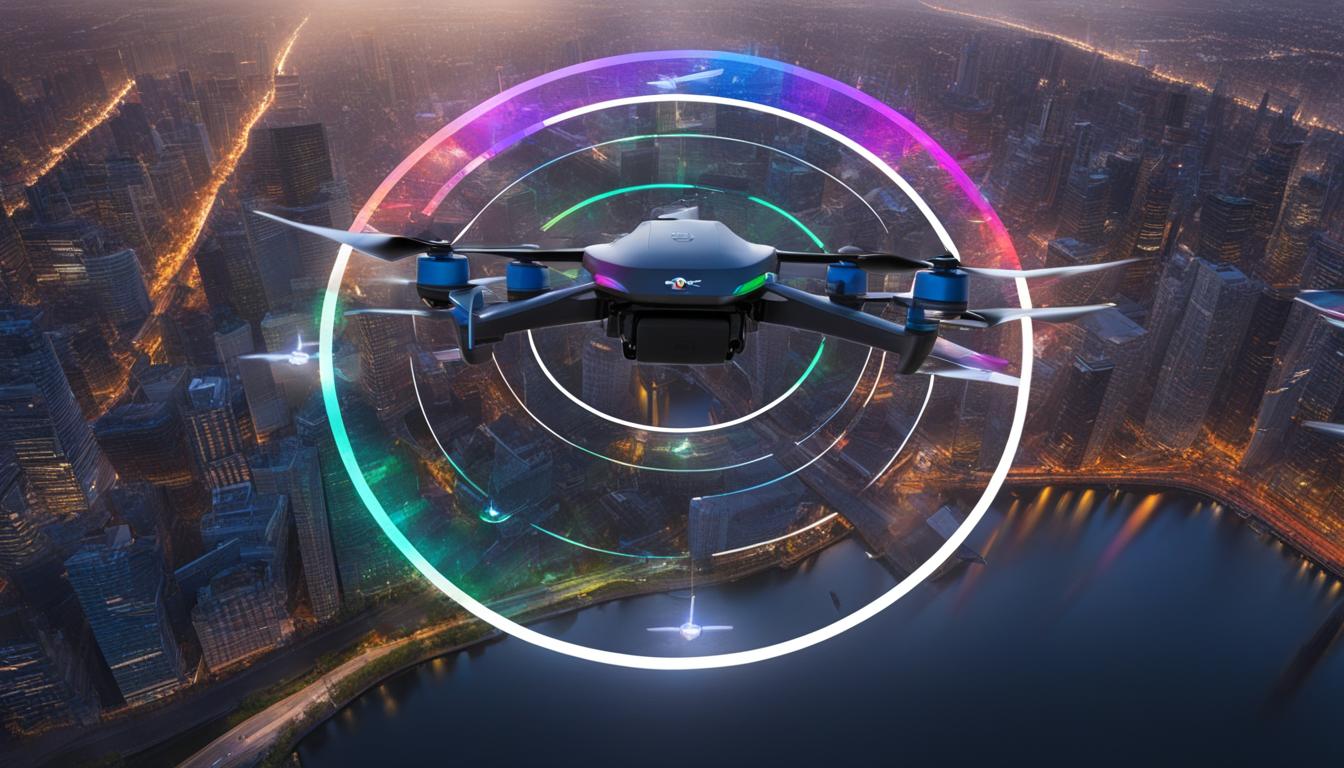
Leave a Reply